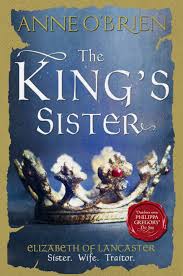A guest post by Anne O’Brien, international writer of historical novels.
What is it that inspires me to write medieval historical novels? Apart from a love of researching the lives and loves of women whose voices have been lost to us in the mists of time, I have discovered all the inspiration I need in the Welsh Marches. It is all here for me in the remote land where England meets Wales. Whether I need some intricate detail of female fashion, a dramatic backdrop, the uncanny role of nature or a moment of spine chilling atmosphere, I can tap into it within a half hour of my front door.
How did women dress in the 1300s? A visit to Lady Blanch Mortimer as she reclines on her tomb in the church at Much Marcle tells it all. The tiny buttons on her sleeves. The cord that fastens her cloak. The full, trailing skirts of her gown that fall beautifully over the edge of her tomb. Her transparent veiling is gorgeous.
 Or there is Elizabeth of Lancaster in the little church of Burford in Shropshire, clad in garments from the same period with gold braid and gold buttons, her cloak edged with ermine as befits a Plantagenet princess. Elizabeth is the main protagonist of my most recent novel The King’s Sister.
Or there is Elizabeth of Lancaster in the little church of Burford in Shropshire, clad in garments from the same period with gold braid and gold buttons, her cloak edged with ermine as befits a Plantagenet princess. Elizabeth is the main protagonist of my most recent novel The King’s Sister.
Do I need to experience life in a castle? Damp and cold in winter, hot and noisome in summer but always with magnificent defensive views over the countryside, I have a choice. There’s little left of Wigmore Castle today, the home of the all-powerful Mortimers, but how it dominates the route between Hereford and Ludlow. Or there is Goodrich, still solid and strong to repel any attack. I can imagine life here under the strong hand of Countess Joan de Valence.
How important is nature in a novel? Visit the battlefield of Mortimer’s Cross early in the morning when the sun is rising. It may be crossed by thundering traffic today, but it’s not difficult to envisage the start of the battle on a misty February morning in 1461 when a parhelion – the image of three suns rising together in the sky – struck fear into the hearts of the Lancastrian forces and they were trounced by the Yorkists.
And then the little Volka chapel in St Michael’s church at nearby Kingsland, to commemorate the dead of that long distant battle. A chilly frisson of history there that touches the spine.
For the bloody aftermath of battle, what better place to stand than by the stone set in High Street in Hereford that marks the spot where Owen Tudor, grandfather of King Henry VII, was executed. Where a ‘madde woman’ washed the blood from his hair and set his head surrounded by a hundred candles on the market cross. It’s not easy to sense the atmosphere in the busy High Street, but it’s not impossible to imagine this tragic event. Owen of course is one of the main characters in The Forbidden Queen, my novel of Katherine de Valois.
As for feisty females. Go to the church in Kington where 15th century Ellen Gethin lies, severe and still in death beside her husband Sir Thomas Vaughan. I doubt she was severe and still in life. Known as ‘Ellen the Terrible’, she avenged her murdered brother David by attending an archery tournament disguised as a man, and shot an arrow through the heart of his murderer.
Or perhaps a romantically inclined lady? Matilda de Clifford, widow of William Longspey, Earl of Salisbury, and owner of Clifford Castle on the banks of the River Wye over towards the Welsh border, petitioned King Henry III when she was abducted and forcibly married. Only to quickly send a second letter, saying that her new marriage was much to her satisfaction and the King need not trouble himself further.
So many threads of stories here. So much emotion and sense of the past
And of course, if it is books themselves that interest me, a visit to the superb Chained Library at Hereford cathedral, with a nod to the Mappa Mundi in passing, draws me. It would be a a true window into history to be able to browse, taking the books carefully from the shelves and turning the pages … Sadly not allowed but the atmosphere catches the breath. These medieval people had a breadth and depth of knowledge. They were thinkers as well as doers.
Historical inspiration? No problem at all. The vibrations of it are in the air in the Welsh Marches.
Visit me and my medieval novels at:

















Good post. I love hearing, how authors go about researching their works.
I have yet to read any books by this author….would love to give them a try. They sound so interesting.
Great post and very interesting!
Sounds a very good read.
Wonderful descriptions, thank you. The Welsh Marshes sound like a fascinating place for
inspiration and writing.
This aticle shows what an excellent writer she is, I could imagine myself in these places as she described them. I’m so enjoying these posts and watching my reading wishlist of more Tudor novels and books grow every day!
I meant “article”!
Another great book, sounds wonderful
I know, it really does.
All the little details
I want to go where she has gone!!